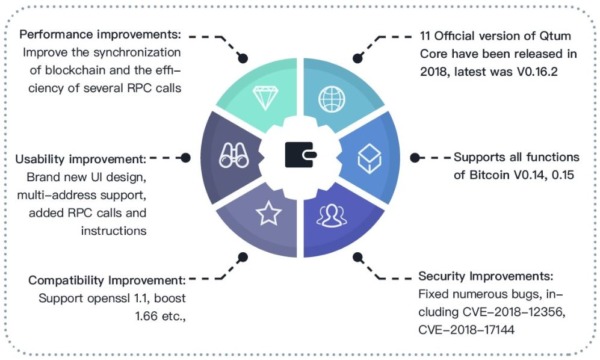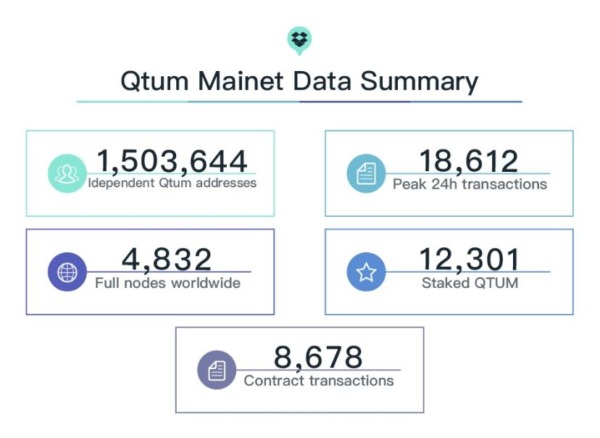Qtum, the enterprise blockchain solution that bridges multiple virtual machines (Ethereum and others) on top of a stable and secure UTXO (Bitcoin-compatible blockchain) while using proof-of-stake (PoS) for verification and a decentralized governance protocol (DGP) for blockchain modification via smart contracts, has just surpassed 10,000 transactions per second (TPS) with QtumX.
On January 22, 2019, the team at Qtum announced that their benchmark testing on QtumX illustrated that the platform can handle more than 10,000 TPS, marking a substantial achievement in the blockchain industry.
Other popular blockchains lag far behind, such as Bitcoin (BTC) with 7 TPS, Ethereum (ETH) with about 50 TPS, and Qtum with about 70 TPS. As for the highest-performing blockchains, Ripple (XRP) can handle 1,500, Stellar (XLM) and Tron (TRX) 2,000, Eos (EOS) about 4,000, and Nano (NANO) 7,000.
Therefore, the benchmark tests from QtumX currently lead the pack for the highest throughput of TPS out of the most popular blockchain projects.
QtumX Introduces a New Scalable Blockchain Solution
Thanks to QtumX’s decentralized governance protocol (DGP), the team was able to introduce a new scalable consensus algorithm called SCAR, which reduces the demand for storage and network resources. This new and innovative consensus algorithm slows down the generating of blocks when transaction volume is low.
In fact, in QtumX, this new system stops generating blocks when there are no pending transactions in the memepool, resulting in efficient management of resources and the potential to handle more than 10,000 TPS.
As stated in the QtumX blog post outlaying the details of their benchmark tests:
“Generated blocks and transactions are shown as follows. You can see that there are five blocks containing more than 10,000 transactions: height 1461, 1459, 1445, 1439, and 1433. This proves QtumX is able to handle more than 10,000 TPS. When there is no transaction, QtumX stops producing new blocks which saves storage and network resources.”
Referring back to the blog post, the benchmark test lasted for just 180 seconds (3 minutes), and the sender was executed 3 times. Each time 50,000 UTXOs were prepared and then sent to the blockchain network. It is expected that we will see more tests resulting in longer time frames on the testnet in the near future.
All in all, the TPS benchmark tests prove that the team at QtumX are well on their way to achieving their goal of developing a platform that’s suitable for the deployment of decentralized applications (dapps). QtumX could be especially useful in business scenarios where a high level of interaction between users and customers is evident.
More Achievements From Qtum
Apart from achieving extremely high TPS with their QtumX blockchain project, Qtum has thrived in a number of other areas as well. At the start of the year, Qtum published their 2018 yearly report outlaying the project’s achievements and progress thus far.
Qtum’s core technology has seen substantial developments including software to run Qtum nodes, communications within the network, management of public/private keys, staking, implementation, and calls of smart contract functions.
In 2018 Qtum’s core technology received 18,151 submissions, 30 releases, and 515 contributors:

In addition to the Qtum core developments above, Qtum achieved multiple developments for their Qtum x86 virtual machine.
These developments include:
- Multi-language support (C/C++/Rust, etc.).
- A new instruction set that supports larger memory space and higher efficiency of code.
- A new memory model and storage mode of contract states.
- DGP-implemented “Trusted Standard Library.”
Also, Unita, the enterprise version of Qtum, saw substantial development throughout 2018 with over 16,686 submissions.
Other substantial developments come from Qtum wallets and blockchain explorer with 11,798 submissions, development tools and documents saw 1386 submissions, and Qtum explorations with 2,486 submissions.
As for the Qtum mainnet, its data summary can be seen below:

All in all, the team and community of Qtum has accomplished a lot in 2018 and continues to innovate and excel in the blockchain industry. Now as we move through 2019, it will be interesting to see if Qtum’s products actually see real world implementations.
What do you think of Qtum and their developments? Will we see real-world implementations of their technology in 2019? Tell us what you think in the comment section below.

